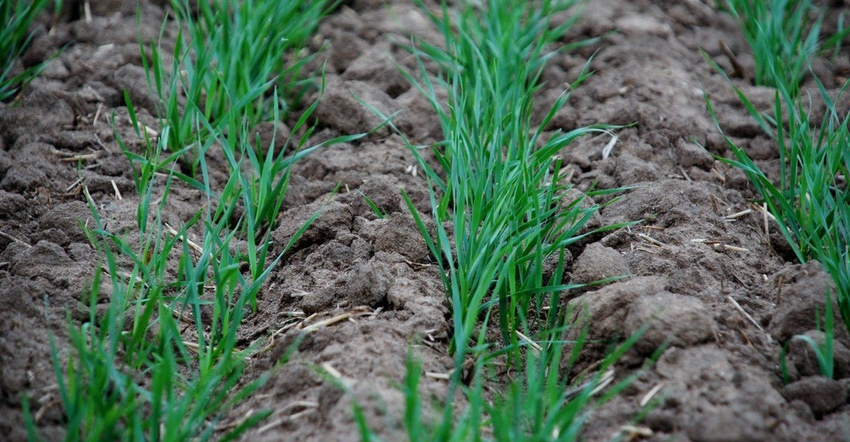
The end of September signals the race to get winter wheat into the ground across much of Kansas. But Kansas Wheat and Kansas State University experts remind growers to consider how they can issues now, for success later.
Planting date
Farmers may use historical knowledge — or even peer pressure from seeing others hit the fields — to decide when they’ll plant their winter wheat. K-State advises farmers to use the right planting dates for their zones and has identified the best management planting dates: Zone 1, Sept.10-30; Zone 2, Sept. 15-Oct. 20; Zone 3, Sept. 25-Oct. 20; and Zone 4, Oct. 5-25.
In the Sept. 9 Agronomy eUpdate, Erick De Wolf, K-State plant pathologist, strongly encourages planting on the later side of the recommended planting dates because:
• Though sometimes earlier-planted wheat can yield better because of that year’s weather conditions, early-planted wheat grows more in the fall and sets more fall tillers. That can use up stored soil moisture and not have it available in a dry spring, when the crop needs to grow.
• Soil temperatures, especially this fall, can be too hot if a farmer plants too early. With much of the state experiencing abnormally hot temperatures this September, farmers need to consider their soil temperatures, agronomists advise.
• Some parts of the state may have had good rains this fall, but early planting can also lead to added disease and insect pressure. Wheat streak mosaic virus (WSMV) and other mosaic viruses, Hessian fly, fall armyworm and barley yellow dwarf are just a few.
Learn more at bit.ly/kstateeupdatesept9.
Seed treatments
Kansas Wheat and K-State also advise growers to strongly consider fungicide and insecticide seed treatments this fall.
“Insecticide seed treatments will help address vectors for diseases like WSMV, while fungicide treatments are necessary to address seed-borne diseases like common bunt and fusarium head blight,” according to Kansas Wheat. In both 2020 and 2021, Kansas growers lost valuable yields to higher-than-usual levels of both those seed-borne diseases.
“Fusarium head blight can reduce stands after planting, while common bunt can ‘remain silent’ within a plant until grain fill, when the starch within the kernel is replaced with black spores,” according to Kansas Wheat.
Fertilization protocols
Dorivar Ruiz Diaz, K-State nutrient management specialist, advises wheat farmers to pay attention to their fertilization protocols this fall for yields next summer.
Wheat is highly responsive to band-applied fertilizers — especially phosphorus, he says. A starter application of phosphorus and nitrogen can lead to significant increase in fall tillers, better root development, and reduction in winterkill.
Choosing a method of application depends on the cost and adaptability for each operation:
1. through the drill with the seed
2. in-furrow application in addition to or instead of preplant phosphorus applications
3. dry fertilizer with air seeders
4. liquid fertilizer applications
Just remember, when applying fertilizer with the seed, limit rates to avoid any toxicity to the seedling. For more advice, visit bit.ly/ksueupdatewheat.
Army cutworms
This year has been a nightmare for farmers dealing with the army cutworms that migrate from the Rocky Mountains back into Kansas each fall, says Jeff Whitworth, K-State Extension entomology specialist. The spring saw army cutworms decimate thin stands of wheat and alfalfa. Then in early summer, armyworms and their cousins, fall armyworms, struck lawns, pastures and alfalfa in the eastern two-thirds of the state, according to the Sept. 16 Agronomy eUpdate.
K-State has cautioned farmers that this year’s larvae are abundant and hungry. They’ve been spotted feeding on alfalfa and emerging stands of wheat and other crops that are actively growing.
Armyworms may cycle through one to two more generations as they overwinter in Kansas. The first hard frost or freeze should stop their spread.
Fall armyworms, however, don’t overwinter in Kansas, and may migrate south after this generation matures into adults. However, K-State cautions there may be another or a partial generation to contend with before that happens. Fall armyworms are hosted in alfalfa, soybeans, corn, sorghum and wheat fields. Read more at bit.ly/ksueupdatearmyworm.
Kansas Wheat and the Kansas State University Department of Agronomy contributed to this article.
About the Author(s)
You May Also Like






